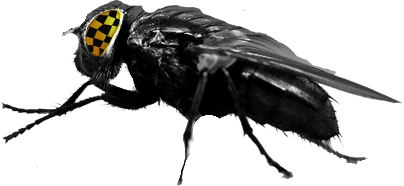Cockroaches Pest Control Information
Cockroaches Pest Control Information
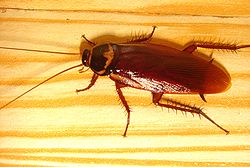
Cockroaches carry diseases such as salmonella, dysentery, gastroenteritis and other stomach complaint organisms. Cockroaches adulterate food and spread pathogenic organisms with their faeces and defensive secretions.
Asthmatic reactions: Cockroaches must moult regularly throughout their life-cycle. The discarded skin becomes airborne and can cause severe asthmatic reactions, particularly to children, the elderly and people with bronchial ailments. The cockroach begins as an egg: The female produces an egg sac which she carries or deposits in a safe place. The young cockroach or "nymph" will undergo a series of moults, shedding it's external skeleton, as it grows to adulthood. The entire life cycle may extend to a few months depending on the species and environmental factors, such as, access to food and moisture, adequate shelter and warm temperatures.
Even the cleanest homes get'em: Cockroach pests and their eggs are spread throughout the community in food and other packaging. Although sanitation and hygiene are important deterrants, even the cleanest homes become infested with cockroaches due to minute deposits of grease, sugar and other food deposits in difficult to get at places, such as, in drains, behind refrigerators and dishwashers, inside cracks and crevices in kitchen cupboards. Omnivorous by nature: Cockroaches will eat almost any organic matter no matter how rancid. Once inside the home, they will seek out food scraps, unsealed food containers, sugar and grease deposits, pet food, rancid meat, glue and even book bindings. YUCK...they eat each others faeces, to feed the young "nymphs" and extract all nourishment from an organic food source.
If you see a clump of pepper-like specs in your kitchen cupboards, it is likely cockroach faeces marking their courtship and nearby nesting territory. Nocturnal feeders: Cockroaches rest during daylight hours in dark warm secure harborages in your home, such as, in wall cavities, the subfloor, roof void, cracks and crevices in the kitchen and bathroom, electrical appliances and foodstuffs. They will emerge from these harborages in the still of the night. Cockroaches have an array of acute sensory and survival instincts. If you see cockroaches in your home during the day, you have a serious problem.
Rapid breeding cycle: If left unchecked a cockroach infestation can rapidly expand it's numbers in a few weeks or months to become major risk to health and safety
Cockroach species identification
Correct identification is essential: There are several cockroach pest species that infest domestic and commercial premises. The identification of each species is neccessary to best determine likely harborage areas and an effective pest control program.
German cockroach - Blatella germanica
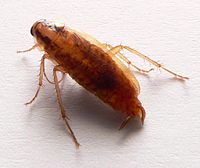
German Cockroach
Identification: The body of an adult german cockroach is about 1/2 inch in length. Biege to light brown in color, with two dark stripes on back of head. World best traveller? The German cockroach is the most widely transported insect pest in the world. Infestations occur even in Alaska and other cold climates in larger installations with central heating or around machinery that produces heat. In warmer climates, it is commonly found in homes, apartments, restaurants, food processing plants, supermarkets and warehouses. Their eggs arrive in food containers, cartons, fridges, stoves and other appliances or materials brought into a building. Habitat: German cockroaches are unable to survive in locations away from humans or human activity. German cockroach infestations usually occur in bathrooms and kitchens. They like to hide-out during the day in tight secure places. Daytime harborage areas are usually near a food and moisture source, such as, inside wall cavities, behind baseboards, cracks and crevices in pantry, kitchen and bathroom cupboards, and under electrical, heating and cooking appliances.
Rapid breeding cycle: The German cockroach is the most prolific breeder among all cockroaches. The female German cockroach lives up to 6 months. She carries an egg capsule containing 30 to 40 eggs. Development from egg to adult can occur in 45 days, during which they moult 6 times. Major problems: lThe German cockroach will breed rapidly throughout the year, but favours a humid environment of around 80F or warmer. An small initial infestation can become a major problem in a few months.
American cockroach - Periplaneta americana
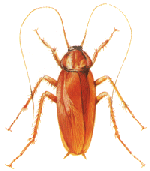
Identification: The largest of the cockroach pest species, the body of an adult American cockroach or "water bug" is 1.5 to 2 inches in length. Color: reddish brown, with a yellowish band behind the head. Habitat: Preferred daytime habitat locations include the subfloor, basement, in sewers and other warm, dark, moist locations. They avoid cold areas but will thrive outdoors in temperatures above 80F. Indoors they often congregate around hot water pipes, fridge motors, boilers and other heating appliances. The American cockroach will feed on a wide variety of plant and animal material.
Rapid breeding cycle: The female life span up to 1.5 years; incubation period of eggs 6 to 8 weeks; in ideal conditions they quickly reach plague proportions.
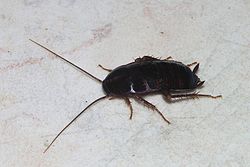
Oriental cockroach --- Blatta orientalis
Identification: The body of an adult oriental cockroach is about 1 inch in length. Dark brown to black in color. Habitat: Most often found in dark basements or cellars, but can also climb garbage shutes, sewer and water pipes to the upper floors in highrise buildings. Oriental cockroaches prefer to feed on starchy foods.
Rapid breeding cycle: The female lives up to 2 years; deposits up to 18 egg-sacs in lifetime; each eggsac contains 16 eggs; incubation period is 1 to 2 months; development period is 12 months, undergoing 7 moults. An infestation will rapidly expand in ideal conditions, particularly during the warm summer months with temperatures regularly above 80F.
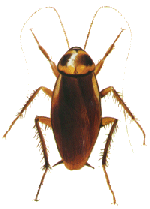
Australian cockroach --- Periplanta australasiae
Identification: the Australian cockroach is reddish brown and looks similar to American cockroach but is smaller at 1.25 inches (35mm) in body length. The Australian cockroach has`yellow strips on the outer edge of the front wings. A world-wide species that prefers a vegetarian diet. It is known to eat holes in clothing and even book covers. Habitat: Generally prevalent in areas where winters are relatively mild. However, in colder climates they are prevalent in greenhouses and near large heating appartus, air-conditioners or other equipment emitting heat constantly. They are opportunistic fliers and will infest anywhere adequate heat, humidity and food supply is available. Prime areas of interest are often pet food bowls and food waste storage areas.
Rapid breeding cycle: The female lives up to 6 months; incubation period of eggs 40 days. An infestation can rapidly expand in ideal conditions, particularly during the warmer climates when temperatures are regularly above 80F. Chronic household infestations usually eminate from the roof void, attic or sub-floor areas of the building.


